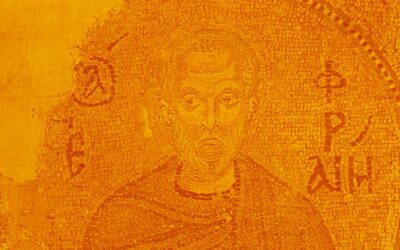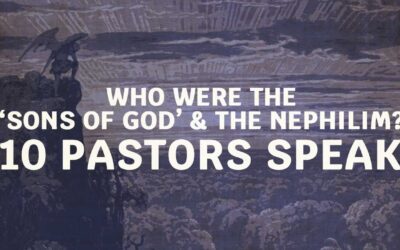
Jerome, also known as Saint Jerome, was a Christian priest, theologian, and historian who lived from around 342–347 to 420 AD. He made contributions to Christianity, particularly through his translation of the Bible into Latin, known as the Vulgate and his commentaries on the Bible, explaining his translation choices and drawing from Jewish tradition.
Jerome’s writings encompassed not only biblical works but also polemical and historical essays, all from a theologian’s perspective.
Jerome’s Hebrew Question on Genesis Explores the Nephilim
In one of his surviving works, titled Hebrew Question on Genesis, Jerome delves into the mention of giants in the Hebrew text, Jerome observes, “Giants. In the Hebrew, it has the following: Falling ones (that is, annaphilim) were on the earth in those days. And after these things, when the sons of the gods used to go in to the daughters of men and breed with them, these were the mighty ones from the beginning, men called by name.”
Here, Jerome acknowledges the Hebrew term “annaphilim” and its connection to the “falling ones” or giants. He further asserts that these “falling ones” can refer to both angels and the offspring of holy beings which supports the involvement of angels in the intermarriages described in the passage.
In 6:2 of Hebrew Question on Genesis, he emphasized the word “eloim,” noting that it could be used to designate both ‘God’ and ‘gods,’ aligning with Aquila’s plural rendering as ‘sons of the gods.’ Consequently, Symmachas too follows the sense of this kind of rendering, and says: “The sons of the mighty saw the daughters of men,” and the rest.
“So when the sons of God saw the daughters of men, that they were comely.” The Hebrew word eloim is of common number; for both ‘God’ and ‘gods’ are designated in the same way. For this reason Aquila dared to say ‘sons of the gods’, in the plural, understanding ‘gods’ as holy ones or angels. “For God stood up in the assembly of the gods: moreover, to the midst of the gods He gives judgement.”
In Verse 4, Jerome describes the physical and spiritual nature of these creatures. He says that they were “giants” on the earth, the “sons of God,” and that they were “men called by name” which suggests that they were physically larger than humans, and had a spiritual power that was derived from their angelic heritage.
“Moreover there were giants on the earth in those days; and after these things, as the sons of God were accustomed to go in to the daughters of men, so they would breed with them. Those were the giants from of old, men called by name.”
T. R Hayward’s (1995) Commentary on Saint Jerome’s Hebrew Question on Genesis
T.R Hayward wrote a commentary on Saint Jerome’s Hebrew Question on Genesis and delved into the nuances of Saint Jerome’s interpretation of Genesis 6:1-4. Let us explore some relevant passages from Hayward’s commentary.
Chapter 6:2
“CHAPTER 6 verse 2
This verse presented obvious problems for orthodox Jewish believers, since it might be interpreted in an anti-monotheistic sense. Hence, from early post-biblical times, these ‘sons of God’ were understood as ‘angels’.
Jerome cites Ps. 82:1 as a proof text for this exegesis. “
Hayward highlights the interpretational challenges that orthodox Jewish believers faced with verse 2 of Genesis 6. To avoid an anti-monotheistic interpretation, these believers began understanding the “sons of God” as “angels.” Jerome, in support of this exegesis, cites Psalm 82:1 as a proof text.
While literal renderings of the Hebrew text were available from the first century onwards, Hayward points out that different versions emerged. Aquila’s version, which Jerome cites, was considered “literal,” as were the versions of Theodotion and the transliteration of Pesh. However, Symmachus introduced a shift in understanding, aligning with a Rabbinic view that interpreted the phrase as “sons of the mighty,” as seen in various texts like TO, PJ, and Gen. Rab. 26:5.
These interpretations aimed to avoid associating the phrase with angels or supernatural beings. Interestingly, Hayward notes that Jerome views Symmachus’ reading as generally consonant with Aquila’s interpretation as we can infer in this passage:
“Literal renderings of the Hebrew, however, were known and used from the first century and onwards, as LAB 3: 1 makes clear: hence Aquila’s version which Jerome cites here, that of Theodotion, and the transliteration of Pesh, which are equally ‘literal’.
The reading of Symmachus, however, betrays a shift of understanding towards a Rabbinic view or the phrase revealed in TO, PJ, and Gen. Rab. 26: 5 (R. Simeon bar Yohai), which also interpret the phrase as ‘sons of the mighty’. This may be compared with TN’s rendering ‘sons of the judges’, found also in Sifre Num. 6; Sifre Zutta 11:4; elohim was taken as ‘rulers’ or ‘judges’, the sense which it apparently has in Exod 22:28. All these interpretations seem designed to avoid any notion of angels or supernatural beings; indeed R. Simeon bar Yohai put a curse on those who spoke of ‘sons of God’ in this verse.
But Jerome appears to view Symmachus’ reading as generally consonant with that of Aquila.”
Verse 4
“The hebrew nepilim, which derives from the root npl, ‘to fall’, was rendered as ‘giants’ by LXX, and Jerome followed this in Vg; it is a common translation, found in Theodotion, TO, and TN, owing much to the appearance of nepilim in Nun. 13:33 (34). There they are huge individuals, making Israel seem like grasshoppers. So they are seen as part of an ancient giant-band which has many names: Gen. Rab. 26:7 gives seven. Not entirely out of kilter with this interpretation is Symmachus, whose translation ‘violent ones’ emphasizes their character without commenting on their physical stature.”
The idea of “nephilim” being associated with giants is reinforced by the account found in Numbers 13:33, where the Israelite spies describe the inhabitants of Canaan as “nephilim,” making the Israelites feel as small as grasshoppers in comparison.
This depiction led to the understanding of “nephilim” as enormous individuals, forming part of an ancient band of giants. Genesis Rabba 26:7 lists seven names associated with this group of giants.
“However, Symmachus provides a different translation for the second occurrence of “giants” in the LXX, using the term “violent ones” to emphasize their character rather than physical stature. The LXX’s rendering of “giants” remains consistent in TO, TN, and PJ for the second occurrence. Aquila translates it as “the powerful,” and Jerome follows this interpretation in the Vulgate, using the term “potentes.” Jerome seems to suggest that Symmachus translated both “nephilim” and “gibborim” as “violent ones,” implying that the supernatural beings and their offspring share a similar nature as “falling ones.”
Symmachus provides a different translation for the second occurrence of “giants.” Instead of using the term “giants,” Symmachus translates it as “violent ones.” This translation places emphasis on the character or nature of these beings rather than their physical stature.
Jerome’s perspective, influenced by Symmachus’ reading, suggests that both the “nephilim” and the “gibborim” can be understood as sharing the character of “falling ones.” This notion aligns with the idea that these supernatural beings and their offspring possess a common nature characterized by their rebellious actions or fall from grace.
Continue the Quest for Understanding
Notably, Jerome presents this narrative as historical, providing no indications of controversy or doubt regarding his understanding. His insights align closely with Jewish tradition, and he incorporates allegorical and mystical subtleties reminiscent of the teachings of Philo and the Alexandrian school.
It is important to note that while Jerome’s interpretation sheds light on the Nephilim and their connection to angelic beings, numerous questions still persist. Unfortunately, the internet is often flooded with disinformation and sensationalized content surrounding the subject of the nephilim in Genesis.
Recognizing this challenge, we, Chasing the Giants aim to provide a dependable resource of searchable data and quality research on this topic. By consolidating ancient sources and engaging in rigorous scholarship, Chasing the Giants strives to offer answers while pointing to the Bible’s ability to explain the imperfections of the world and the truth found in Jesus.






